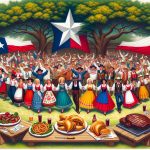
Promoting Polish culture in America is a varied effort. It includes celebrating traditional festivals, educational programs, exploring Polish cuisine, and sharing Polish arts and literature. This effort not only adds to America’s cultural diversity but also helps connect different communities by showing them the rich heritage of Poland.
Yet, figuring out the best ways to weave Polish culture into the broader American scene brings its own set of challenges and chances. As we dive into this, we can think about how this might help keep Polish culture alive and enrich our shared values in society.
Celebrating Traditional Festivals
Celebrating traditional Polish festivals in America is a great way to showcase Poland’s rich cultural heritage. These festivals, from lively Polka music events to the reflective Easter traditions, bring people together, promoting understanding and appreciation of Polish culture among Americans from all walks of life. People get to experience authentic Polish food, dance, and art, which encourages cultural exchange and fosters mutual respect. These celebrations not only keep alive the traditions of Polish immigrants but also add to America’s cultural diversity.
For example, attending a Polka music festival, you’re likely to see energetic dances and hear upbeat tunes that are central to Polish culture. It’s a direct way to experience Polish traditions and the community spirit. Similarly, Easter traditions in Poland have a deeply spiritual side that is observed through various customs, providing insights into the country’s religious practices and values.
By participating in these festivals, everyone, regardless of their background, gets a taste of Poland. It’s an opportunity to learn about a new culture through direct experience, which is often more impactful than reading about it. These events serve as a bridge, connecting different communities and enhancing the multicultural landscape of the United States.
In essence, celebrating Polish festivals in America is about more than just fun. It’s a means of cultural preservation, education, and building a sense of community among diverse groups. It reflects the idea that America’s strength lies in its diversity, and by embracing and understanding different cultures, we enrich our own lives and the fabric of American society.
Educational Initiatives
Educational programs are key in helping Americans understand Polish culture better. These programs are often organized by cultural institutions and community centers. They cover various aspects of Poland, including its history, arts, and the Polish language. For example, language courses help people learn Polish, making it easier for them to connect with Polish culture. History seminars provide insights into Poland’s complex history, helping people appreciate the country’s contributions to the world. Art exhibitions and film screenings showcase Polish creativity, bridging cultural gaps.
Such initiatives do more than just add to the cultural diversity in America; they also strengthen the friendship between the two countries. They offer Americans a glimpse into the Polish way of life, promoting mutual respect and understanding. For instance, a film screening of a Polish movie can open discussions about Poland’s societal themes, while an art exhibition featuring Polish artists can highlight the country’s rich artistic traditions.
In a nutshell, these educational efforts are crucial for fostering a deep appreciation of Polish culture in America. They are not just about learning a new language or history; they’re about connecting people and building bridges between cultures. By participating in these programs, Americans can enjoy a richer, more diverse cultural experience while also contributing to stronger ties between Poland and the United States.
Culinary Adventures
Diving into Polish culture isn’t just about reading books or attending lectures; it’s also about tasting its food. Poland’s culinary scene is a vibrant mix of flavors and traditions that reflect its history, geography, and the way of life of its people. From the hearty dumplings known as pierogi to the flavorful sausage called kielbasa, and not forgetting the sweet treat of paczki doughnuts, Polish cuisine offers a window into the nation’s soul.
Understanding Polish culture through its food does more than just please the palate. It opens up a dialogue about the country’s past, its varied climate, and the differences between regions. For example, pierogi can be filled with anything from potatoes and cheese to fruits, showing the adaptability of Polish cuisine to various tastes and ingredients available across the country.
In America, promoting Polish food through events like cooking classes, food festivals, and specialized dining experiences can serve as an engaging way to introduce people to Polish traditions. This not only celebrates the richness of Polish cuisine but also helps build a deeper appreciation for Poland’s culture. It’s a hands-on approach that encourages people to learn about and respect different ways of life, adding new flavors to the American cultural mix.
To make this experience accessible, consider recommending local Polish restaurants or online platforms that offer Polish cooking classes. This practical advice gives readers a direct way to explore Polish cuisine themselves. By actively participating in these culinary adventures, individuals can forge a personal connection with Polish culture, enriching their understanding and appreciation of this diverse and storied nation.
Arts and Literature
Exploring Polish arts and literature reveals much about the country’s history and the collective spirit of its people. Poland has a vibrant art scene that includes painting and a rich tradition in literature and theater that has made a mark on the world. Notable individuals like Wisława Szymborska, a Nobel Prize-winning poet, and Frédéric Chopin, a revolutionary composer, highlight the creativity and endurance that Poland is known for. Through their stories and art, Polish creators have dealt with complex historical events, contributing to a sense of national identity.
Polish literature, for example, is known for its deep narrative and ability to convey complex emotions and historical events in a relatable way. Meanwhile, Polish theater has often led the way in experimenting with form and content, making it a significant part of the global theatrical landscape.
An example of Poland’s contribution to global culture is the music of Chopin, whose compositions continue to be celebrated worldwide for their emotional depth and technical brilliance. Similarly, Szymborska’s poetry, with its insightful observations on human life and the natural world, has resonated with readers around the globe.
These artists and their works not only showcase Poland’s rich cultural heritage but also help connect people from different backgrounds. For those interested in experiencing this culture firsthand, exploring Polish literature translated into English or attending a Chopin concert can be great starting points. These experiences offer a window into the Polish soul, promoting a deeper understanding and appreciation of this vibrant culture, both in America and elsewhere.
Community Organizations
Community organizations centered on Polish culture play a crucial role in the United States. These groups, usually started and run by people with a deep connection to Poland, either through heritage or interest, act as key places for sharing and celebrating Polish traditions. They host a variety of events like festivals that showcase Polish customs, concerts featuring Polish music, dance shows, and even Polish language classes. This not only gives Americans a chance to experience the diverse aspects of Polish culture but also helps Polish Americans stay connected to their heritage.
For example, one might find a festival in the heart of a city where traditional Polish foods like pierogi and kielbasa are served, alongside performances of Polish folk music and dances by people wearing traditional Polish attire. These festivals not only bring Polish Americans together but also attract a broader audience, showcasing the richness of Polish culture to a wider group of people.
Moreover, these organizations offer more than just events. They create a community space where people with Polish roots can find familiarity and belonging, and where others interested in Polish culture can learn and participate. This helps maintain the cultural heritage of Poland in the U.S. and adds to the country’s multicultural fabric.
In essence, these community organizations are essential for promoting and keeping alive the cultural practices, languages, and traditions of Poland in the U.S. They bridge the gap between generations of Polish Americans and introduce the wider American public to the beauty of Polish culture, enriching the cultural diversity of the nation.
Conclusion
To sum it up, promoting Polish culture in America involves a lot of different activities. From enjoying traditional festivals, learning about its history and culture, trying out Polish food, to exploring its arts and literature, and supporting Polish community groups.
All these actions help to add more color and diversity to the cultural scene in the US, while also keeping Polish traditions alive and well. It’s about making sure that everyone in American society can learn about and appreciate what Polish culture has to offer, making our cultural landscape richer and more welcoming for everyone.






Comments are closed.